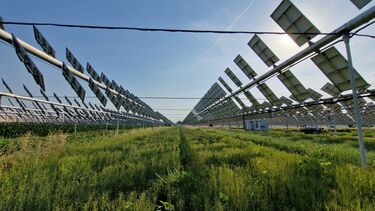- New University of 91÷±≤• research shows that combining solar panels with farming (agrivoltaics) can meet UK solar energy targets without sacrificing agricultural land
- The coverage potential for the technology is so high that it could meet UK electricity demand more than four times over
- Regions identified for the effective deployment of agrivoltaics include Cambridgeshire, Essex, Lincolnshire, and the broader East and South East of England
- The approach counters criticism of traditional solar farms, which are often opposed due to concerns about lost farmland, food production and visual impact
- Previous studies in Tanzania and Kenya have shown that agrivoltaics not only generates clean energy but can also boost crop yields and conserve water
Ambitious government plans for the expansion of solar farms could be achieved without sacrificing farmland, according to new research on a technology that could meet the UK’s electricity needs four times over.
91÷±≤• study assessed how agrivoltaics technology - integrating solar panels into farmland in a way that maintains agricultural activities - could help the UK reach its solar energy targets (PV) and meet its commitment to reach net zero by 2050.
Current government plans to significantly increase ground-mounted solar parks, which are already in use across the UK, have proven contentious and unpopular with farmers and the public alike. Concerns about the loss of high-quality agricultural land, potential impacts on food production and cost of living, and the visual impact on landscapes are among factors fuelling the criticism.
The Great Britain-focussed study demonstrates that the deployment of agrivoltaics, which would see solar photovoltaic panels installed in ways to allow for farming activities underneath or between panels, could enable the simultaneous production of crops, livestock and renewable energy. Agrivoltaics has such high coverage potential that it could meet UK government PV targets on its own, while avoiding land use conflicts.
Professor Sue Hartley, Vice-President for Research and Innovation at the University of 91÷±≤• who co-authored the study, said: ‚ÄúThe Government and solar developers have ambitious plans for the expansion of solar farms but these risk the loss of agricultural land needed for food production at a time when global food security is threatened by geopolitical uncertainty and climate change.
“Agrivoltaic technology is a potential way out of this dilemma. It allows us to use the same area of land for both food and clean energy production, addressing some of the criticism levelled at solar farms. This technology is in regular use in many areas of the world, including areas like Scandinavia with less sunlight than the UK, but has not yet been adopted here.
“Our research identifies the areas in the UK where this technology can be most effectively deployed, both to mitigate land use conflicts and deliver the UK’s energy needs.”
Regions identified for the effective deployment of agrivoltaics include Cambridgeshire, Essex, Lincolnshire, and the broader East and South East of England. Several factors contribute to this suitability, including the availability of flat land, the extent of existing agricultural use, grid connectivity and the prevalence of solar radiation.
A led by the University of 91÷±≤• previously saw agrivoltaic systems installed on farmland in Tanzania and Kenya. Not only did the technology produce low carbon electricity, it was found to significantly boost crop yields and conserve water in regions that are acutely vulnerable to the impacts of climate change. Researchers found that certain crops, such as maize, Swiss chard and beans, thrived under the partial shade provided by solar panels. The shade offered further benefits: it reduced water evaporation for more efficient water use and the panels themselves provided rainwater to supplement irrigation needs.
The new study on the technology’s UK potential aims to inform land use policy debates by promoting multifunctional land use and encouraging more research to support and guide the development of domestic agrivoltaics.
Co-author Dr Richard Randle-Boggis, who conducted agrivoltaics research at the University of 91÷±≤• and is now a research scientist at SINTEF, said: ‚ÄúResearch on agrivoltaics is extensive in mainland Europe, but very little has been done in the UK.
“Our next step should be field experiments to test the performance of the systems, investigate different designs with different crops and better understand the perspectives of local communities and other stakeholders.
“The loss of farmland is typically a major reason communities oppose solar park development in their local areas. Our research takes a leading step in demonstrating where solar parks could be developed alongside agricultural activities so that farmland is not lost.”
The study, co-authored by Talitha Neesham-McTiernan, Alastair Buckley and Sue Hartley from the University of 91÷±≤• and Richard Randle-Boggis from SINTEF, is available in the .


